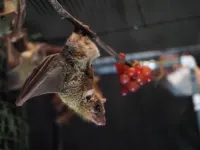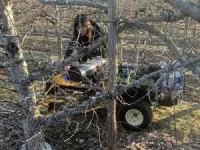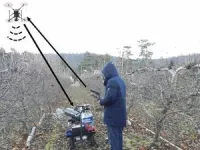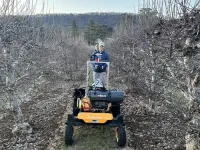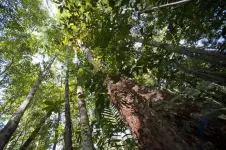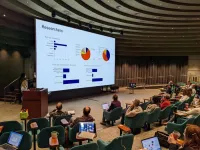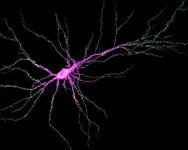(Press-News.org) The vocalizations of humans, bats, whales, seals and songbirds vastly differ from each other. Humans and birds, for example, are separated by some 300 million years of evolution. But scientists studying how these animals learn to "speak" have time and again seen surprising similarities in the connections in brain regions that support this vocal learning.
In a paper published in the journal Science, a multi-institutional team led by scientists at Carnegie Mellon University and the University of California, Berkeley, found parts of the genome, both within genes and outside them, that have evolved and are associated with vocal learning across mammals.
Employing a machine learning approach called tissue-aware conservation inference toolkit (TACIT) on the Pittsburgh Supercomputing Center's Bridges-2 system, the laboratory of Andreas Pfenning identified 50 gene regulatory elements from the brains of humans, bats, whales and seals that have a stronger relationship to vocalization. These regulatory elements are DNA sequences outside the actual genes that direct what genes are active in which tissues.
Scientists have come to understand that regulatory elements play a big role in the evolution of behaviors. But studying them has been much more difficult than studying the genes.
"New artificial intelligence methods were needed to help find evolutionary signals in regulatory elements across hundreds of genomes," said Pfenning, a corresponding author on the new study and an associate professor in CMU's Ray and Stephanie Lane Computational Biology Department affiliated with the Neuroscience Institute and Department of Biological Sciences. "We're entering an exciting era where AI is improving our ability to trace human evolutionary history. Studying the gene regulatory elements requires building a map of which ones are active in the relevant brain region of species with vocal learning behavior."
That relevant brain region was found through experiments conducted in the laboratory of UC Berkeley's Michael Yartsev, another corresponding author. They found evidence that a specific part of the Egyptian fruit bat brain has similar neural connections to the part of the human brain that controls speech production.
“Very few mammals are actually capable of learning the sounds that they make, which makes it very difficult to study this core aspect of humanity,” said Yartsev, an associate professor of bioengineering and neuroscience at UC Berkeley. “We were able to identify parallels between bats and humans in the structural elements of the brain, the genetic content, and even the neural circuitry that control vocal learning.”
Both vocal-learning-associated genes and the gene regulatory elements discovered in this study also tend to reside in parts of the genome related to autism spectrum disorder. This finding suggests that studying the evolutionary history of the human genome can provide clues to how it influences human health.
"The types of cells that form long-range connections in the human and bat brain are the same ones that we discovered as most relevant to vocal learning based on the genetic analysis," Pfenning said. "The anatomy and genetics are both pointing to the same mechanism underlying the evolution of vocal learning across mammals and speech production in humans."
This highly interdisciplinary research was based on funding and support from CMU's School of Computer Science, Mellon College of Science, and the Dietrich College of Humanities and Social Sciences through the university's Neuroscience Institute.
END
Similar genetic elements underlie vocal learning in mammals
AI-identified non-gene regulatory DNA associated with autism in humans
2024-02-29
ELSE PRESS RELEASES FROM THIS DATE:
Q&A: How a potential treatment for Alzheimer’s disease could also work for Type 2 diabetes
2024-02-29
Of the 38 million Americans who have diabetes at least 90% have Type 2, according to the Centers for Disease Control and Prevention. Type 2 diabetes occurs over time and is characterized by a loss of the cells in the pancreas that make the hormone insulin, which helps the body manage sugar.
These cells make another protein, called islet amyloid polypeptide or IAPP, which has been found clumped together in many Type 2 diabetes patients. The formation of IAPP clusters is comparable to how a protein in the brains of Alzheimer's disease patients sticks together to eventually form the signature plaques associated with that ...
Cyber-physical heating system may protect apple blossoms in orchards
2024-02-29
UNIVERSITY PARK, Pa. — Spring frosts can have devastating effects on apple production, and a warming climate may be causing trees to blossom early, making them more susceptible to the damaging effects of extreme cold events. Growers’ attempts to prevent the flowers from freezing by attempting to heat the canopies of their orchards largely have been inefficient.
To deal with the worsening problem, Penn State researchers devised a frost protection cyber-physical system, which makes heating decisions based on real-time temperature and wind-direction data. The system consists of a temperature-sensing device, a propane-fueled heater that ...
NYC ranks safest among big US cities for gun violence, new research from NYU Tandon School of Engineering reveals
2024-02-29
New York City ranks in the top 15 percent safest of more than 800 U.S. cities, according to a pioneering new analysis from researchers at NYU Tandon School of Engineering, suggesting the effectiveness of the city’s efforts to mitigate homicides there.
In a paper published in Nature Cities, a research team explored the role that population size of cities plays on the incidences of gun homicides, gun ownership and licensed gun sellers.
The researchers found that none of these quantities vary linearly with the population size. ...
A landmark study maps the precise orchestration of prenatal development
2024-02-29
In a landmark study, researchers at University of Washington and The Jackson Laboratory have characterized, in exacting detail, the rapid series of events that transform a single fertilized cell into a living, complex being. The work, reported this month in Nature, not only has enabled the team to explore which genes drive the differentiation of hundreds of cell types, but also shows, for the first time, that there are very rapid changes in genetic activity within the hour immediately following birth, underscoring the speed with which newborns must adapt.
“The ...
Unveiling rare diversity: the origin of heritable mutations in trees
2024-02-29
Tropical trees are at the heart of this study. They are essential for climate regulation, maintaining biodiversity and providing crucial resources for many local communities. Understanding how they evolve genetically is therefore of vital importance for preserving biological diversity and finding sustainable solutions for tropical forest adaptation to the environmental pressures they face.
The aim of this study was to identify the mutations accumulated during growth by two specimens of tropical trees sampled in French Guiana, a French overseas department covered to 96% by tropical forest. To do this, the scientists ...
Tandem cycling linked to improved health for those with Parkinson’s, care partners
2024-02-29
EMBARGOED FOR RELEASE UNTIL 4 P.M. ET, THURSDAY, FEBRUARY 29, 2024
MINNEAPOLIS – Pedaling on a stationary bicycle built for two may improve the health and well-being for both people with Parkinson’s disease and their care partners, according to a small, preliminary study released today, February 29, 2024, that will be presented at the American Academy of Neurology’s 76th Annual Meeting taking place April 13–18, 2024, in person in Denver and online.
“Our study found that a unique cycling program that pairs people with Parkinson’s disease with their care partners can improve ...
Preprints raise possibility of rethinking the peer-review process as they become more widely used and accepted
2024-02-29
Preprints raise possibility of rethinking the peer-review process as they become more widely used and accepted – new article encourages their growing momentum and provides recommendations to empower researchers to provide open and constructive peer review for preprints
#####
In your coverage, please use this URL to provide access to the freely available paper in PLOS Biology: http://journals.plos.org/plosbiology/article?id=10.1371/journal.pbio.3002502
Article Title: Recommendations for accelerating ...
A new channel for touch
2024-02-29
Every hug, every handshake, every dexterous act engages and requires touch perception. Therefore, it is essential to understand the molecular basis of touch. “Until now, we had known that the ion channel – Piezo2 – is required for touch perception, but it was clear that this protein alone cannot explain the entirety of touch sensation,” says Professor Gary Lewin, head of the Molecular Physiology of Somatic Sensation Lab at the Max Delbrück Center.
For over 20 years Lewin has been studying the molecular basis of the sensation ...
Scientists identify new ‘regulatory’ function of learning and memory gene common to all mammalian brain cells
2024-02-29
Johns Hopkins Medicine neuroscientists say they have found a new function for the SYNGAP1 gene, a DNA sequence that controls memory and learning in mammals, including mice and humans.
The finding, published March 1 in Science, may affect the development of therapies designed for children with SYNGAP1 mutations, who have a range of neurodevelopmental disorders marked by intellectual disability, autistic-like behaviors, and epilepsy.
In general, SYNGAP1, as well as other genes, control learning and memory by making proteins that regulate the strength of synapses — the connections between brain ...
Ultraviolet “winds” erode a young star’s protoplanetary disk in Orion Nebula
2024-02-29
Ultraviolet “winds” from nearby massive stars are stripping the gas from a young star’s protoplanetary disk, causing it to rapidly lose mass, according to a new study. It reports the first directly observed evidence of far-ultraviolet (FUV)-driven photoevaporation of a protoplanetary disk. The findings, which use observations from the James Web Space Telescope (JWST), provide new insights into the constraints of gas giant planet formation, including in our own Solar System. Young low-mass stars are often surrounded by relatively short-lived protoplanetary disks of dust and gas, which provide the raw materials from which planets ...
LAST 30 PRESS RELEASES:
Manta rays create mobile ecosystems, study finds
Study: Mixed results in using lipoic acid to treat progressive multiple sclerosis
Norbert Holtkamp appointed director of Fermi National Accelerator Laboratory
New agentic AI platform accelerates advanced optics design
Biologists discover neurons use physical signals — not electricity — to stabilize communication
Researchers discover that a hormone can access the brain by hitchhiking
University of Oklahoma researcher awarded funding to pursue AI-powered material design
Exploring how the visual system recovers following injury
Support for parents with infants at pediatric check-ups leads to better reading and math skills in elementary school
Kids’ behavioral health is a growing share of family health costs
Day & night: Cancer disrupts the brain’s natural rhythm
COVID-19 vaccination significantly reduces risk to pregnant women and baby
The role of vaccination in maternal and perinatal outcomes associated with COVID-19 in pregnancy
Mayo Clinic smartwatch system helps parents shorten and defuse children's severe tantrums early
Behavioral health spending spikes to 40% of all children’s health expenditures, nearly doubling in a decade
Digital cognitive behavioral treatment for generalized anxiety disorder
Expenditures for pediatric behavioral health care over time and estimated family financial burden
Air conditioning in nursing homes and mortality during extreme heat
The Alps to lose a record number of glaciers in the next decade
What makes a good proton conductor?
New science reporting guide published for journalists in Bulgaria
New international study reveals major survival gaps among children with cancer
New science reporting guide published for journalists in Turkey
Scientists develop a smarter mRNA therapy that knows which cells to target
Neuroanatomy-informed brain–machine hybrid intelligence for robust acoustic target detection
Eight SwRI hydrogen projects funded by ENERGYWERX
The Lundquist Institute and its start-up company Vitalex Biosciences Announces Strategic Advancement of Second-Generation fungal Vaccine VXV-01 through Phase 1 Trials under $40 Million Competitive Con
Fine particles in pollution are associated with early signs of autoimmune disease
Review article | Towards a Global Ground-Based Earth Observatory (GGBEO): Leveraging existing systems and networks
Penn and UMich create world’s smallest programmable, autonomous robots
[Press-News.org] Similar genetic elements underlie vocal learning in mammalsAI-identified non-gene regulatory DNA associated with autism in humans
